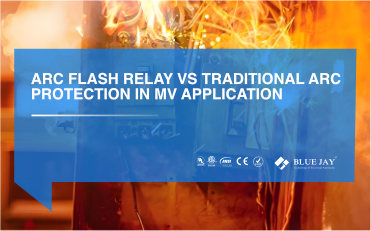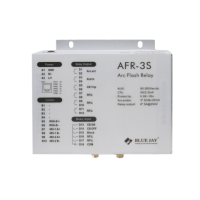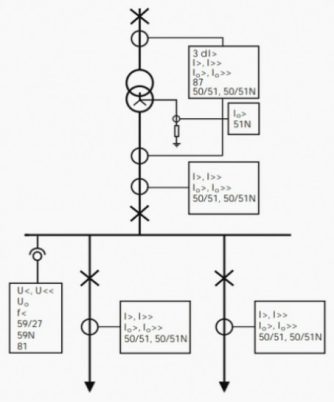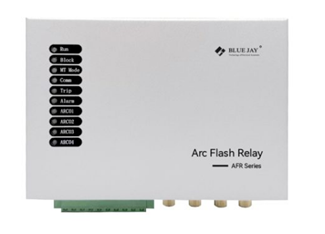
Vamp 125 vs AFR-4 – what is difference
Importance of Arc Protection Arc faults are high-risk electrical

Is there any difference between arc flash relays and traditional arc protection methods? Of course, there are differences between them. This article will compare conventional protection systems in medium voltage applications, showing the difference when arc flash protection is included versus when it’s not.
The arc protection relay adopts advanced arc flash detection technology and combines arc and current sensors to quickly and accurately detect arc faults. This dual-sensor logic ensures immediate tripping in case of faults like short circuits or insulation breakdowns, minimizing damage and enhancing switchgear safety.

Traditional arc protection methods mainly rely on overcurrent protection devices, such as differential relay circuit breakers and fuses, to cut off the circuit by detecting the magnitude and duration of the fault current, thereby limiting the duration of the arc fault. When using traditional time-grading or lock-based protection coordination principles, traditional protection systems may not be able to provide fast enough substation fault protection. In addition, high-impedance grounding faults may cause arc faults to last longer and release more arc energy.
Differential relay protection is also a traditional arc fault protection method. Taking differential relays as an example, when an arc fault occurs within the protection range of differential protection, if the current generated by the arc fault is large enough, resulting in an imbalance of current flowing into and out of the device exceeding the action threshold of the differential relay, the differential protection can also operate to cut off the fault, thereby limiting the duration and energy of the arc to a certain extent. However, additional CTs need to be installed using this arc protection method, and it is not sensitive enough to low-amplitude arc faults.
In medium voltage (MV) applications, both types of arc protection solutions are available. A professional comparison reveals that the biggest differences lie in the total arc fault clearing time, performance, and cost. Arc protection relay offers faster clearing times, better performance, and lower cost.


1. Total arc fault clearing time
Total arc fault clearing time for conventional protection system without arc protection relay:
Outgoing feeder 50 (relay)+ 50 (CB)= 100 ms (+ Auto-reclosing)
Incoming feeder 350 (relay)+ 50 (CB)= 400 ms
Total arc fault clearing time for conventional protection system with arc protection relay:
Outgoing feeder 14 (relay)+ 50 (CB)= 64 ms
Incoming feeder7(relay)+ 50(CB)= 57 ms
2. Performance
In terms of performance, Arc protection relays have higher response speed and detection accuracy. For example, Blue Jay’s AFR-4 arc protection relay uses an arc sensor with a sensitivity of 8000 lux (±20%) and current detection to achieve a millisecond arc detection response. It has 6 relay outputs and 5 digital inputs and can flexibly configure protection actions and linkage logic. In addition, it also supports Fail-safe/Non-Fail-safe working modes and has a self-holding reset function, front panel, and remote reset options, which are suitable for medium-voltage systems with high reliability requirements.

Blue Jay AFR-4 arc protection relay
Current & light sensing
4 arc flash channels
In contrast, although traditional bus differential protection has high accuracy in judging internal faults in the bus area, it relies on the accurate installation and matching of current transformers (CTs), has high requirements for system symmetry, and usually has a long detection response time for arc-type breaking faults. It is also difficult to handle situations where strong light is accompanied, but the current change is not significant. At the same time, the traditional arc protection solution does not have a light detection function, cannot directly identify the arc light source, has a dead zone blind spot problem, and has limited recognition capabilities for non-metallic faults and grounding faults.
3. Cost
If you want to install a traditional bus differential relay in a medium voltage bus switchgear to achieve arc protection, you need to install an expensive CT. This will lead to higher investment costs. But if you install an arc flash relay, you don’t need to install costly CT. You only need to install arc sensors in different areas; one arc protection relay can connect multiple arc sensors. Therefore, the arc flash relay is less expensive.
Modern power systems usually use dedicated arc protection relays or combine differential protection with other arc flash mitigation methods to achieve faster and more reliable arc protection.

Importance of Arc Protection Arc faults are high-risk electrical

Abstract: This article will introduce you Switchgear arc flash

Calculating arc flash is very important for youto get




